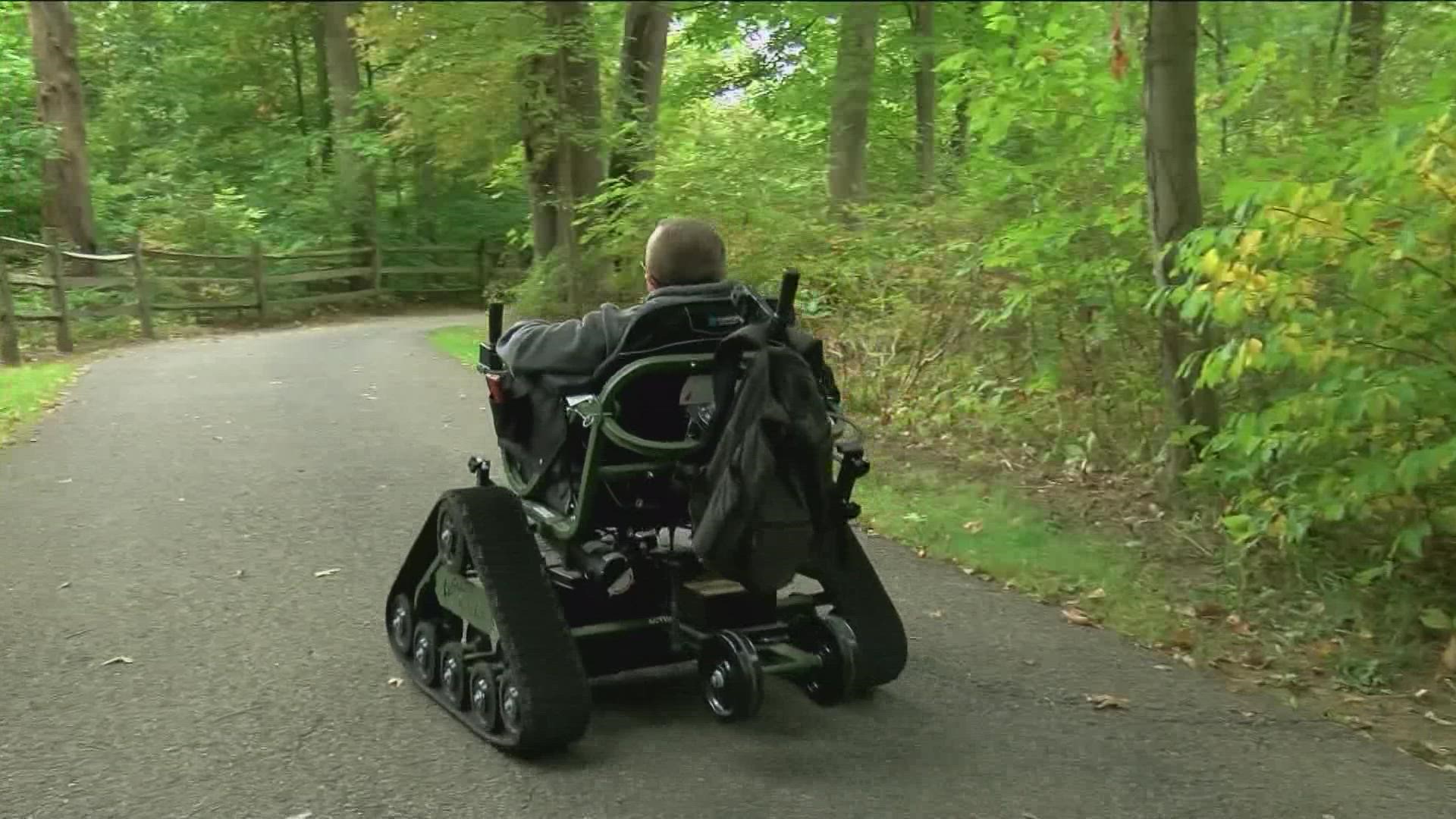Are you looking for mobility and independence? You’ve come to the right place.
All terrain wheelchairs provide a convenient solution, giving users around the world greater freedom. In this post, we’ll explore the key features of all-terrain wheelchairs and how they can help you maintain your independence.

For individuals with disabilities, the freedom to explore difficult terrain can be a life-altering experience. Thanks to the technological advancements of all-terrain wheelchairs, people are now able to head off road and over rugged, uneven terrain that was once thought impossible. Before purchasing an all-terrain wheelchair, it’s important to familiarize yourself with the features that make up this type of chair. This guide will provide comprehensive information about all-terrain wheelchairs so that anyone considering this mobility solution can make an informed choice.
First, we will look at the materials used in all-terrain wheelchairs for increased durability and stability in outdoor environments. Next, we’ll cover how these chairs are designed for maximum maneuverability. We will also discuss seating options for enhanced comfort and safety as well as customization options for greater personalization of your chair. Finally, we’ll look at some care and maintenance suggestions to ensure your wheelchair remains in tip top condition for many years to come!
Definition of All-Terrain Wheelchairs
An all-terrain wheelchair, also known as an off-road or powerchair, is a highly specialized form of wheelchair designed to be used on rugged terrain such as dirt roads, grassy hills and even sand dunes. It usually has high-traction tires and a reinforced frame to help it navigate through challenging surfaces. All-terrain wheelchairs are designed to provide a safe and comfortable ride in any difficult environment without sacrificing performance.
These specialized wheelchairs use features like suspension systems, adjustable seat height, adjustable seat depth and back angle, animal activated brakes and larger frames for greater ease of navigation. In addition to their functionality, these chairs often boast eye-catching designs that range from more traditional models to more adventurous styles with added elements like camouflage or colorful graphics. All terrain wheelchairs come in a variety of sizes so you can find the perfect one for your needs—no matter where you choose to go!
Factors to Consider When Choosing an All-Terrain Wheelchair
Finding an all-terrain wheelchair that meets your needs can be a difficult and time-consuming task. There are many factors to consider when choosing the perfect model for you. Here is a comprehensive list of factors to keep in mind:
- Size: All-terrain wheelchairs come in different sizes, so make sure to measure your body size and weight and compare it with the dimensions of the chair before purchasing. Also, look for models that have adjustable components to ensure a comfortable fit.
- Weight: All-terrain wheelchairs are typically heavier than standard wheelchairs due to their durability, so you must take into account your own strength and the assistance you may need while using it. Consider looking at lightweight models or power chairs if you want greater mobility without compromising on usability features like suspension and performance requirements.
- Maneuverability: All-terrain wheelchairs should be maneuverable enough on all surfaces, including rough terrain such as gravel or sand, mud, uneven ground, snow, and steep inclines or declines. Check out product specifications concerning maneuverability before making a purchase decision, such as turning radius and ability to be self-propelled (or pulled along by another person).
- Suspension: Suspension systems should absorb shock from off-road terrain while providing sufficient rigidity for user stability when traversing hills or bumps in the terrain. Look at suspension systems that offer both adjustable firmness as well as adjustable height settings for improved flexibility in different road surfaces/weather conditions/user preferences etc.
- Comfort: Comfort should be of utmost importance when choosing any wheelchair but even more so when looking at all-terrain ones because they are usually used on offroad areas where they expend more energy than standard wheelchair models due to the additional features required for navigation through difficult terrain (suspension system etc.). Look out for long lasting cushions which provide comfort over long periods of use as well light backrests with adequate padding support needed during long seating sessions outside of home/medical facility.
User’s Physical Abilities and Needs
It is important to consider the user’s physical abilities and needs before selecting an all-terrain wheelchair. For example, a person with limited range of motion and dexterity may need a chair that allows them to easily maneuver through uneven terrain.
A person with strength and balance issues will be more likely to benefit from an electric power-assist feature on their chair, as it will make controlling the wheelchair much easier. Additionally, other features such as high ground clearance, adjustable seat heights, and equipped storage options can further enhance the user’s experience.
Weight and Portability
An important feature of all-terrain wheelchairs is the weight and portability of the chair. Some models can tip the scales at over 50 pounds, making them difficult to transport, especially for those who do not require full time use of a wheelchair. However, there are models that are specifically designed to be lightweight and highly portable, with some weighing in below 25 pounds.

When researching different types of all-terrain wheelchairs, it’s important to consider the total weight with any accessories that you plan to add. This includes spare parts for repairs as well as cushions or backpacks for added convenience and comfort. Additionally, many chairs have detachable frames which allow them to be broken down into smaller components that can easily fit into a trunk or storage box.
III. Maintenance and Safety Tips for All-Terrain Wheelchairs
The maintenance and safety of all-terrain wheelchairs are essential factors to consider when deciding on the type of wheelchair unit to purchase. It is important to be aware of the various instructions for use, maintenance and repair in order to keep your all-terrain wheelchair in top condition for continued use.
In this section, we’ll discuss some important tips to keep your wheelchair safe:
-Regular Checkups – As with any other piece of equipment, regular checkups should be done to ensure that your wheelchair is running properly and remains safe for its continued use. Additionally, regular checkups can help catch maintenance or repair issues before they become a bigger problem.
-Safety checks – Before taking your all-terrain wheelchair out on the trails or other rough terrain, make sure it is in proper working order by checking brakes, tires and any additional components.
-Secure accessories – Make sure that any accessories you have attached are securely fastened so they don’t become loose while you’re driving. This goes double while going on rougher terrain where small movements could cause a potential hazard.
-Replace parts when needed – If you have parts that are worn or look like they need replacing, it’s best to replace them as soon as possible rather than waiting until further damage has been incurred due to lack of maintenance.
By taking the advice provided above into account you will be able to maintain a safe and reliable all-terrain wheelchair that can withstand anything you may come up against during regular use.
Cleaning and Maintenance
Cleaning and maintenance are essential to getting the most out of the performance and durability of all-terrain wheelchairs. As with any other wheelchair, dirt, dust, grime, and debris need to be regularly removed from the chair. Regular maintenance and inspection will help keep all-terrain wheelchairs functioning properly for years to come.
It is important to check for potential wear or damage regularly. Although all-terrain wheelchairs are designed for rugged terrain, it is important not to neglect signs of wear as this can compromise its durability over time. Some key components that should be inspected include castor forks, brakes system, caster wheels, armrests and foot plates. Wheels should be checked for dirt build up that can affect their performance. Ensure that nuts and bolts are fastened securely in place throughout the frame and suspension components including shocks absorbers. The battery must also be inspected on a regular basis since full power capabilities are dependent upon a fully charged battery. Cleaning should always include wiping off sweat as it not only affects hygiene but also encourages corrosion over time if left unremoved.
Regular Check-ups and Repairs
Regular maintenance and repairs of your all-terrain wheelchair are essential for a safe and enjoyable experience. To ensure that your chair is in good condition and functioning optimally, you should check the following factors at least once every month:
- Use a damp cloth to clean off any dirt and debris from the chair frame, wheel rims, brakes, axles and seat surface to avoid accumulation of dirt leading to corroded parts.
- Visually inspect all parts of the chair including tires, wheel-rims, seat belts and screws to ensure they are not worn down or damaged due to wear and tear.
- Test each part of the chair components separately according to manufacturer’s specifications. This includes checking if the brakes work correctly, axle nuts are tight and wheel bearings are functioning properly. Make sure that the tires do not show signs of excessive wear or deflation due to air leakage.
- Ensure safety features such as headlights or taillights, if equipped with one, are working correctly in order to keep you visible at night time for added safety measures during your rides on rougher terrains or trips over longer distances.
If you detect a fault during regular checks or encounter any problems while using your all terrain wheelchairs take them immediately for repairs. Pay attention to undesirable squeaking noises that indicate possible problems with brakes or wheel rims which could result in hazardous conditions if left unattended.
Safety Precautions
One of the primary concerns when using an all-terrain wheelchair is the risks associated with travel on uneven surfaces or slopes. It is important to take certain measures before and during use to ensure the safety of the user.
Before any mobility session, it is essential to inspect the equipment for any signs of damage, wear and tear, or malfunctioning of any component. This should include checking for air pressure in tires, alignment issues, proper functioning of brakes and hand-rims, and ensuring that all locking mechanisms are secure.

Once these safety measures are taken care of, it’s equally important to plan your route carefully so as to avoid steep inclines or declines that may present a challenge beyond your ability or experience level. If you’re unsure about your route’s suitability for use with an all-terrain wheelchair, seek guidance from a qualified professional before continuing on your way.
When approaching changes in terrain such as rocky windy paths or rough roads made up of cobblestones, make sure you approach them slowly while mindfully controlling the chair’s speed in order to maintain stability and control at all times. You should also be mindful of turning at high speeds on uneven surfaces which can cause involuntary tipping over or coming off course due to centrifugal force. In many cases additional assistance from an able-bodied individual may be necessary to properly navigate these environments in such a manner that does not pose any risk to either participant.
Finally, it’s always best practice for anyone using an all-terrain wheelchair to keep hydrated and well nourished throughout their journey in order to minimize fatigue and improve their overall safety level during maneuverable activities off-road.
Conclusion
In conclusion, the use of all-terrain wheelchairs has revolutionized mobility solutions for individuals with physical limitations and disabilities. These wheelchairs are built to overcome any type of terrain and weather conditions, enabling them to enjoy long-distance journeys in the outdoors. They come in a variety of models, all tailored to meet different needs and preferences.
The most important aspects to consider when selecting an all-terrain powered wheelchair are size and weight, frame layout, seat design, battery type, brake system and accessories. By researching all of these factors closely, one can find a suitable ATV wheelchair that will meet their individual needs and improve their quality of life.
FAQs
What are the features of a wheelchair?
The features of a wheelchair include a frame, seat, footrests, wheels, tires, hand rims, axles, and brakes, as well as additional features such as a backrest, headrest, and armrests.
What are the different types of all terrain wheelchairs?
The different types of all-terrain wheelchairs include manual wheelchairs with off-road tires, power wheelchairs with enhanced suspension and terrain capabilities, and specialized outdoor mobility devices such as the Trackchair.
What features should I look for in a wheelchair?
When selecting a wheelchair, important features to consider include the weight and size of the wheelchair, the type of wheels and tires, the level of adjustability, and additional features such as a backrest, armrests, and footrests.
Is there an all terrain wheelchair?
Yes, there are all-terrain wheelchairs specifically designed for off-road use and outdoor mobility.
What is the full function of wheelchair?
The primary function of a wheelchair is to provide mobility and independence for individuals with mobility impairments. Additionally, wheelchairs can provide postural support and pressure relief for users.
What are the three types of wheelchairs?
The three types of wheelchairs are manual wheelchairs, power wheelchairs, and transport wheelchairs.
What is the most important part of a wheelchair?
The most important part of a wheelchair is the frame, as it provides the structure and support for the entire wheelchair.
What are the main parts of a wheelchair?
The main parts of a wheelchair include the frame, seat, backrest, footrests, wheels, tires, hand rims, axles, and brakes.
What is the specification of standard wheelchair?
A standard wheelchair typically has a seat width of 18 inches, a seat depth of 16 inches, and a weight capacity of around 250 to 300 pounds. It may also have adjustable footrests, armrests, and a backrest.
What is the feature of electric wheelchair?
Electric wheelchairs have features such as a motor, rechargeable batteries, joystick or other control system, and options for adjustable seating, leg rests, and other customization options to provide mobility and independence for individuals with mobility impairments.
See Also-
- Best wheelchair for paraplegic 2023
- Best wheelchair for elderly 2023
- Best wheelchair carrier 2023
- Best wheel chair cushions for pressure sores 2023
- Best electric wheelchair 2023


